Finding Dead Birds In The Thick Stuff
By Jerry Thoms
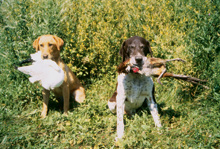 Freshly shot or frozen then thawed game birds make good tools for learning and practicing a search on the "hunt dead" command. All photo by Jerry Thoms. |
When a rooster erupted from the corn stubble, Ray shot twice, pulling a few feathers from the long-tailed pheasant. The bird, however, kept on flying 200 yards then suddenly folded up to drop like a sack of rocks into the middle of a 100-foot-wide, head-high stand of thick wet cattails.
"Let's get the dogs over there," Ray said as he called to Kate, his 18-month-old yellow Labrador retriever. And Gene, his hunting buddy, whistled for Mac, his nine-month-old German shorthaired pointer.
Though neither dog had seen the rooster fall, both hunters had a pretty good fix on the bird's location in the tall dense cover and felt sure the dogs would find it.
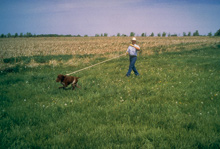 A check cord is useful in teaching any dog how to establish a search zone when practicing "hunt dead" exercises. |
Twenty minutes went by and neither dog found anything, despite their owners' efforts to get their canines to hunt for the obviously dead ringneck.
"The dogs don't seem to get the idea that we're looking for a dead bird," Gene said to Ray. "I guess they want to go somewhere else to find a live bird." And so they did, leaving the dead rooster for the foxes or the worms.
Retrieving a mortally wounded or dead game bird can be a big part of any canine's responsibility on a typical hunt for upland game or waterfowl. For most dogs, fetching up a pheasant that falls in short grass or a duck that drops in open water is pretty simple--watch the bird go down, then go get it.
But what about the goose that tumbles into an unpicked cornfield or the grouse that crashes into dense underbrush, and the dog doesn't see the bird go down? Though the hunter may have a pretty good sense of the game's location, finding the bird in deep and tangled cover will be up to the dog.
Most gun dogs of any breed can be taught to hunt for dead game birds in any kind of heavy habitat where pheasant, grouse, quail, partridge, duck, or goose may be hidden by vegetation. Using some basic techniques and simple tools, anyone can teach a gun dog to search for a dead bird with a few training sessions at home, in the field or on a hunt.
The 'Hot Dog' Method
Though Ed Erickson, at his Autumn Breeze Kennel in central Minnesota, mainly trains versatile gun dog breeds for titles in the North American Versatile Hunting Dog Association (NAVHDA), AKC Hunt Tests, and North American Shoot To Retrieve Association (NASTRA) events as well as many hunting contests, he has taught all breeds of gun dogs to "hunt dead."
"Most all gun dogs have an innate instinct to put their noses to the ground in search of game birds, either alive, wounded or dead," Erickson says. "As trainers, all we need to do is shape this natural ability into something habitual and controllable by giving them a reason to 'hunt dead' on command. The first steps in this process can be done with pieces of a hot dog.
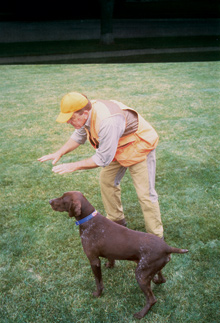 A gun dog owner's tone of voice and body posture--think low--can provide effective audio and visual cues for a dog to go into the "hunt dead" or "dead bird" mode. |
"Take an ordinary hot dog, cut it into half-inch slices, then scatter these pieces on the basement floor in the house, on the concrete in the garage, or on the mowed grass in the yard. Then bring out a pup as young as seven weeks or a dog of any age that needs lessons in hunting dead. Just as they drop their noses and scoop up that first hot dog piece say 'hunt dead' or 'dead bird'," Erickson instructs. "With this kind of snack as a reward, most dogs will soon get into the habit of putting their noses to the ground when someone says 'hunt dead' or 'dead bird'."
Once a dog regularly drops its head and puts its nose to the ground on the "hunt dead" or "dead bird" command, the trainer then needs to transition from hot dog pieces to retrieving dummies and then to actual dead birds, both frozen and freshly killed set out in knee high to waist-high cover. "Smear a little hot dog on the dummies and the real birds as a way to at first make them easier to find. Soon the dog will set its attention on just the dummies and actual birds," Erickson says.
To initially keep rambunctious dogs in the dead bird search zone, Erickson suggests using a check cord for control. "Use the check cord to establish a dead bird search perimeter that most dogs will soon adopt once they find dummies and dead game in the area," Erickson says.
Using a hot dog to teach "hunt dead" basics is only a first step to be followed by other more sophisticated methods to get any gun dog more proficient at finding shot game that falls in heavy cover. "The hot dog search is just designed to get a dog to associate the 'dead bird' or 'hunt dead' command with putting its head down and its nose to the ground to look for something," Erickson emphasizes.
Customized Dummies
"Though most any breed of hunting dog usually will search for and retrieve a commercially-made plastic or canvas dummy, gun dogs will more likely find and fetch a dummy with real game bird feathers or commercially made scent on it," says Randy Bartz, a professional gun dog trainer from Oronoco, Minnesota. "By tying, taping, or gluing on upland game bird or waterfowl feathers and adding a specific scent to a dummy made from synthetic material, the new dimensions of sight, feel, and odor are added. For a dog, all this makes the dummy more interesting, easier to find, and closer in appearance, texture, and smell to a real bird."
Bartz advises using dried primary wing feathers for attaching to a dummy because these feathers are tougher and will resist the damage caused by being tossed on the ground or into water and by being picked up over and over by a dog. "Cut the wings on any game bird at the elbow so that only a minimum of muscle remains. You can treat the wing with borax, a laundry product, that will draw the moisture from the meat and at the same time make the feathers hold on better," Bartz suggests.
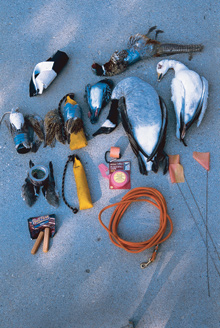 The tools for teaching gun dogs to "hunt dead" are simple, inexpensive, and readily available. Hot dogs cut into slices and scattered on the ground can be used to encourage any hunting dog to get its nose down at the "dead bird" command. Likewise, commercially-manufactured retrieving dummies can be made into facsimiles of game birds by tying, taping, or gluing feathers to them. And real pigeons, upland birds, or waterfowl can be set out in heavy cover on land or water to give all breeds of gun dogs practice in finding dead birds. A check cord works to keep a dog in the search zone and fluorescent tape or blaze orange flags help the handler to keep track of where "dead birds" are located in a training session. |
A sticky duct tape, a plastic cinch tie or a hot glue gun can be used to secure the feathers to a plastic, canvas, or foam type dummy. "Though these feathers can be pretty tough, they will deteriorate. So, when used in wet grass or in water for hunt dead training, be sure to dry them off before storing. And watch every dog, especially puppies, to keep the feather dummy from becoming a chew toy," Bartz warns.
Commercially made liquid scent, in the aroma of pheasant, duck, and some other game birds, can be rubbed on a plastic dummy or injected with a syringe into a dummy made from canvas or a foam-like material. Does this scent have the exact aroma of the game bird pictured on the bottle? "Only the dog knows the answer to that question," Bartz says. "The important feature of added scent is that the odor seems to make the dummy more attractive and easier to locate, in the process keeping the dog more involved in the 'hunt dead' training session."
As with any other type of dummies, those with feathers attached and scent added are handy to take along on a local close-to-home training session or on a cross-country road trip where dead bird fetching lessons can be taught whenever the opportunity arises.
Using Freshly Shot Game Birds
When Jim Rieser, owner-operator of Shooting Starr Kennel in Franksville, Wisconsin, teaches 'hunt dead,' he uses the real thing to get the lessons across. "Whether we're out for ducks or geese on water or land or after pheasants, quail, ruffed grouse or woodcock, during the hunt or at the end of the day we gather up all the birds we've killed and use them for 'hunt dead' training," Rieser says.
"Having dogs search for and find real game birds in the same habitat we hunt them in is one of the most realistic and most successful methods for teaching and practicing the 'hunt dead' experience.
"We scatter just-killed ducks in wet cattails or in flooded slough grass. And we hide dead geese in corn stubble or under small grain windrows. Then we take the dogs to these places and tell them 'dead bird' or 'hunt dead'," Rieser says. With upland game birds, Rieser and his hunting partners follow the same procedure by putting birds in the same sort of places the dogs hunt them, such as high prairie grass for pheasants or bramble patches for ruffed grouse.
For long-term hunt dead training, Rieser suggests filleting the breast and leg meat from a game bird, wrapping the remaining carcass in duct tape, then freezing the body with all its feathers intact. "The tape wrapped bird can be partially thawed and hidden in heavy cover to provide a pretty realistic 'hunt dead' opportunity," Rieser says.
When hiding birds, whether placed by hand or thrown into cover, you need to keep track of where you put them. "We use one-inch wide plastic tape in blaze orange tied to pieces of vegetation or attached to lightweight rods three to four feet long and stuck in the ground or in the mud to mark the spots where we've set the birds. This makes it easier to see when the dogs are closing in on the birds so we can better direct and encourage them," Rieser says.
"We sometimes pair a pup with an older, more experienced adult so that the younger dog will follow the older dog as a way of learning from example," Rieser says. "If the experienced dog stays in the search zone, the pup will usually stay close by and join in the hunt for a dead bird.
"In some instances, adding more dogs to the mix creates a competitive factor that keeps all the dogs working harder. But sometimes too many dogs just creates chaos, so be careful when you do this," Rieser advises.
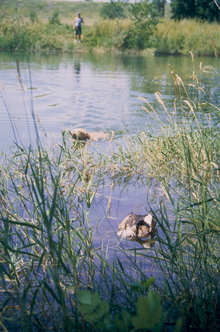 Finding dead birds is a big part of any gun dog's job on a hunt for upland game or waterfowl. Though most breeds will have an innate instinct to look for shot game on land and in water, this natural ability to search for dead or wounded birds can be enhanced through some simple training methods. |
The dog handler's voice tone and body posture are also factors in creating the "hunt dead" mode, Rieser feels. "One of my hunting buddies was the first to notice something I didn't realize about myself when he pointed out that our dogs responded to my long drawn out 'hunt dead' verbal command. Likewise, the dogs seem to react to my hand and arm positions and slightly stooped body as visual cues to go with this 'dead bird' search," Rieser adds.
Repetition of these training experiences is the key to making any breed of dog into a good dead bird finder, Rieser has found. "Don't miss an opportunity to put your dead birds to work in teaching your dog how to 'hunt dead'."
Conclusion
"We're looking for a big 10-pound Canada goose we dropped in this little patch of cattails," one of the hunters standing on the edge of the gravel road said when other hunters in a passing truck stopped to ask what they were searching for.
"Sure, you can use your dogs to look for the dead goose," was the answer to the question, "Would you like some help from a Labrador retriever and a German shorthair?"
The two dogs jumped from the truck and bounced into the three-acre slough and, on the "hunt dead" command, put their noses down and started the search for the honker.
After several months of training for exactly this kind of "hunt dead" opportunity, here was a sort of final exam for each of the canines. When 15 minutes had gone by, however, nothing was found where the two hunters said the goose had gone down.
The two dogs were moved over 100 yards toward the other end of the cover despite the objections of the hunters, who felt the bird couldn't have fallen there.
A few minutes later someone said, "Look at this!" as the shorthair and the Lab came marching in, each holding on to one wing of the dead goose.
Which dog first found the bird? "Doesn't matter; either one could have done it after their lessons in 'hunt dead
'," the Lab guy told the shorthair owner.
For most hunters having their dogs find shot game birds dropped and otherwise lost in heavy cover is a thrill as great as shooting the bird in the first place. With some regular training and practice in the "hunt dead" method, any gun dog can become good--even great--at recovering dead birds.






